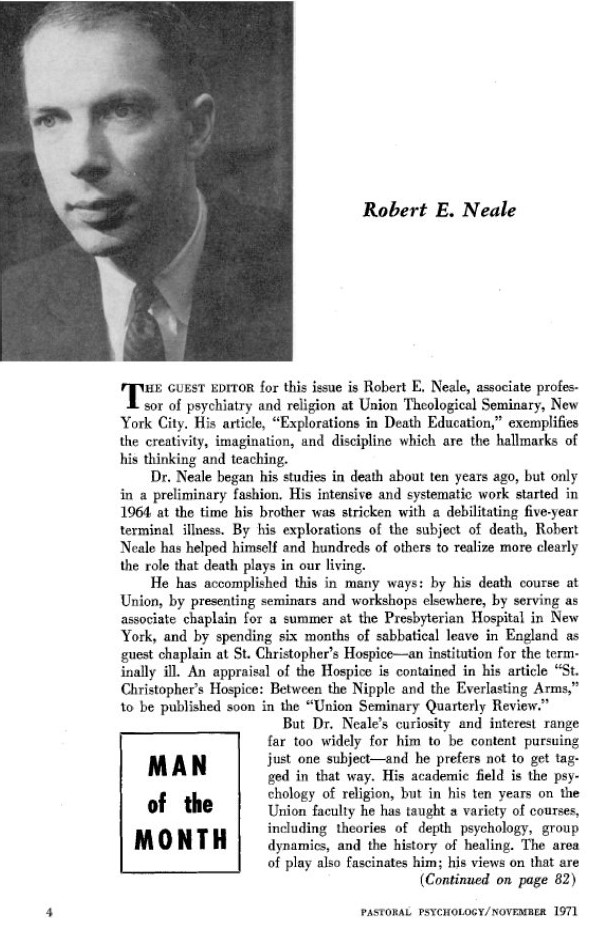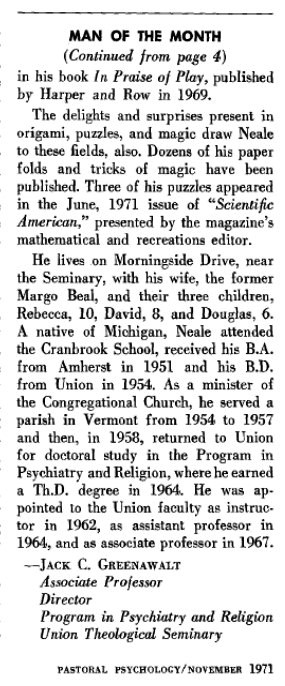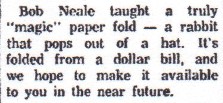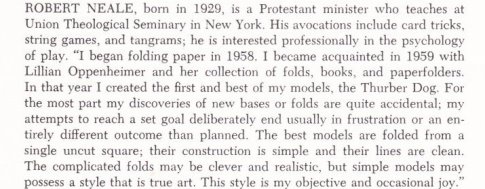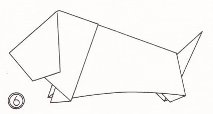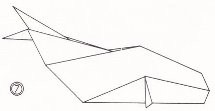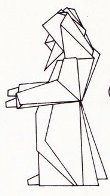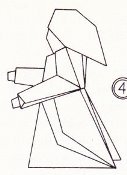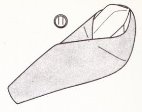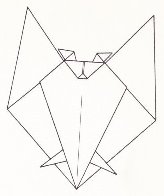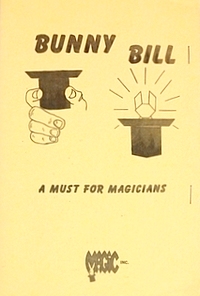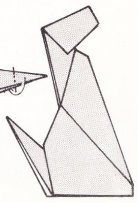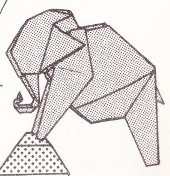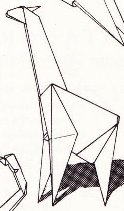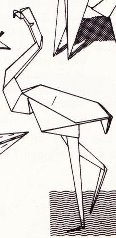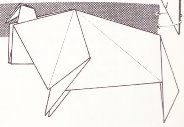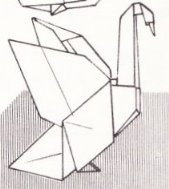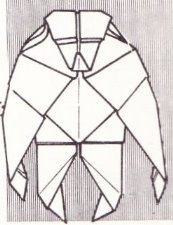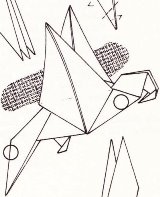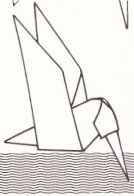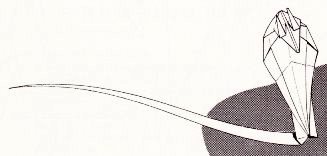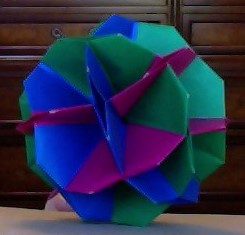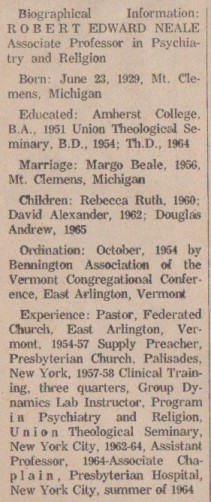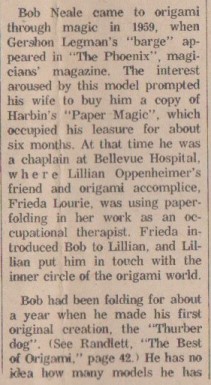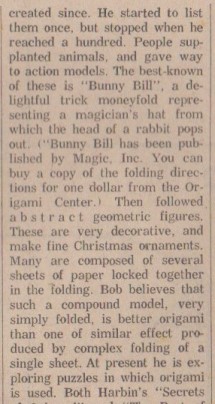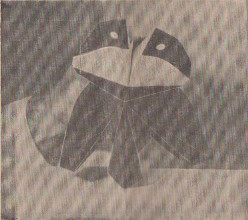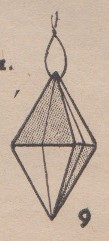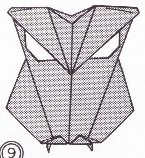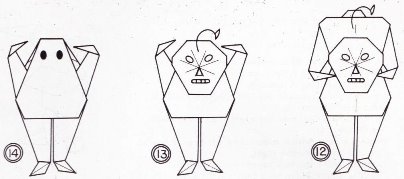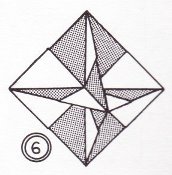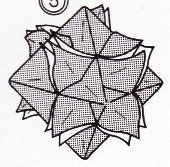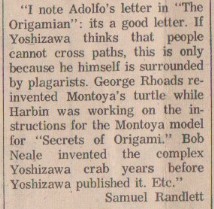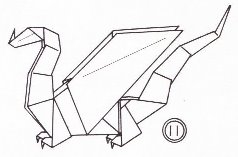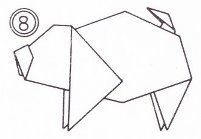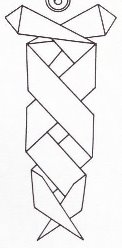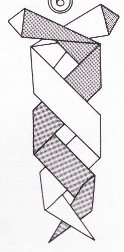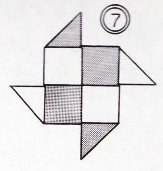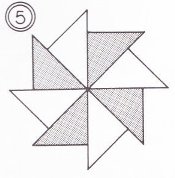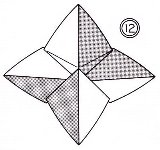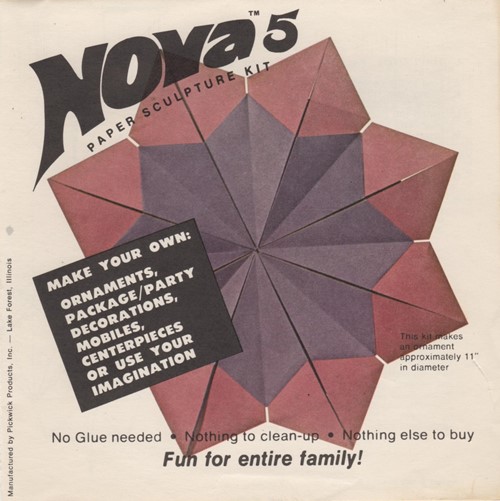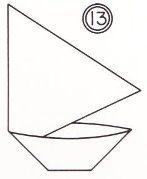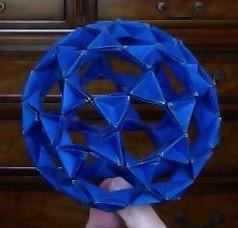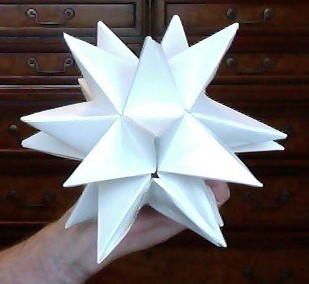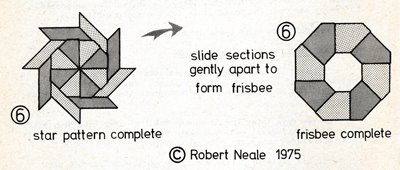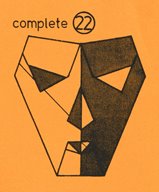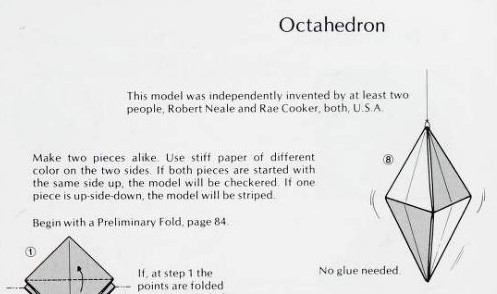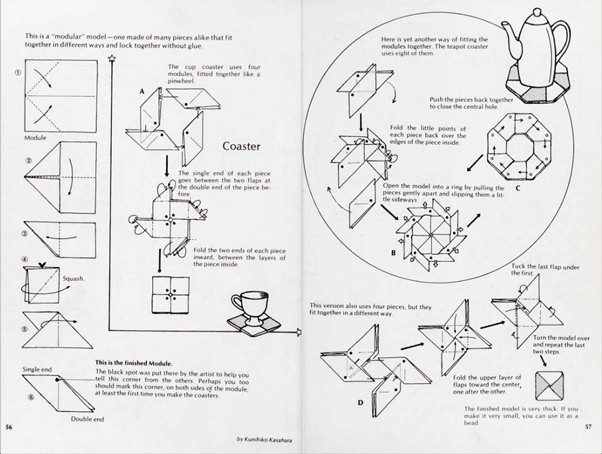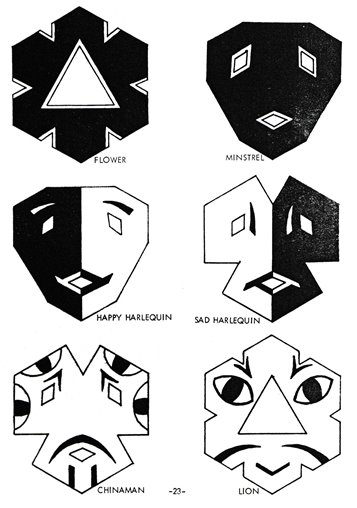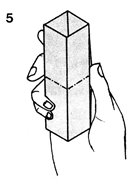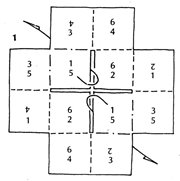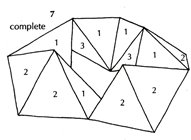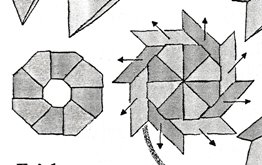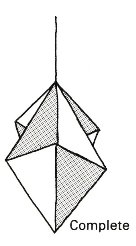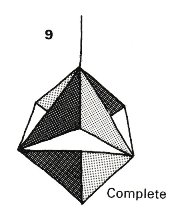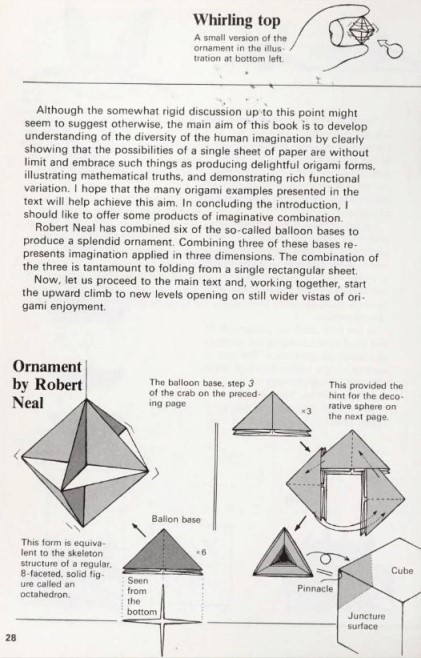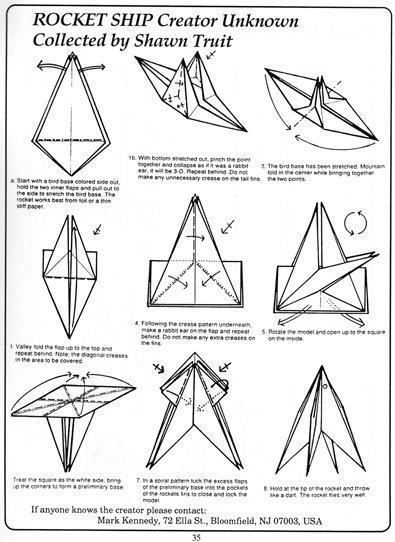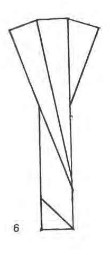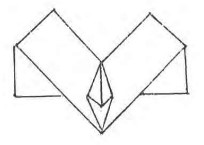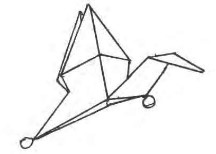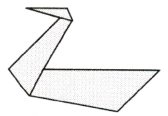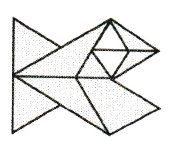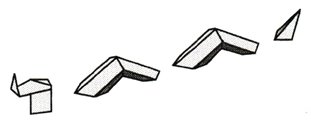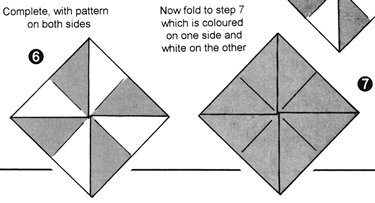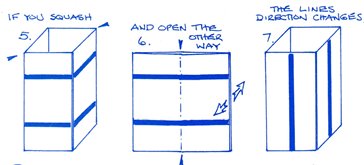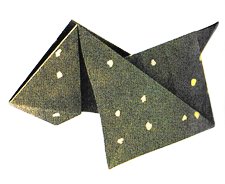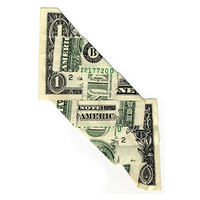| The Public Paperfolding History Project
Last updated 31/12/2023 x |
|||||||
| The Paperfolding of Robert E Neale | |||||||
This page is being used to collect information about Robert E Neale and his paperfolding. It started out as a bibliography and is in the process of being turned into a page of a more biographical nature. British Origami is the magazine of the British Origami Society (BOS). Le Pli is the magazine of Mouvement Français des Plieurs de Papier (MFPP). Orison and Minori are magazines of Origami Society Netherlands (OSN). ********** Introduction Robert Edward Neale was born on June 23rd 1929 in Mt Clemens, Michigan. He became interested in conjuring, in 1939, when he was ten, after attending one of Harlan Tarbell's magic shows, and went on to become a well-known amateur magician, inventing many original tricks and writing many books on the subject. He became interested in paperfolding after seeing an article explaining how to fold 'Cleopatra's Barge' by Gershon Legman. (This article was published in 1952 but it seems Neale did not encounter it until 1958.) According to a profile in 'The Origamian' of Autumn 1968 'The interest aroused by this model prompted his wife to buy him a copy of Harbin’s ‘Paper Magic’. At this time Neale was working as a chaplain at Bellevue Hospital in New York, where Frieda Lourie also worked as an occupational therapist, using paperfolding in her work. Lourie introduced him to Lillian Oppenheimer and he is mentioned (mispelt as Robert Neil) in Meyer Berger's famous article about Oppenheimer's love of paperfolding, which was published in the New York Times on 27th June 1958. He was one of the original 'Honorary members' of Oppenheimer's 'Origami Center' (this time listed as Robert Neal). ********** Neale as Theologian Professionally, Robert Neale was a theologian and minister. The best summary of his career as a theologian that I have found is this one from the issue of 'Pastoral psychology' for November 1971, in which he was profiled as 'Man of the Month' in
********** Neale as Magician The best resource to learn about Neale's approach to magic and his many inventive tricks is the website Celebrating Illusions: A website dedicated to the magic of Robert E Neale. ********** Neale as Paperfolder Unlike many other paperfolding designers, Robert Neale has produced designs in many paperfolding genres. Much of his early published work was of representational designs, but from the mid 1960s onwards he was also experimenting with modular designs, paperfolding puzzles and effects based on flexagons. Many of his later representational designs are playful, deliberately simple, and come with some kind of story or performance patter attached. Paperfolding also features as an element in many of his magical effects. The chronology below now concentrates solely on Neale's career as a paperfolder and on his published paperfolds, paperfolding related puzzles and magical effects etc. It originally contained references to the publication of some early non-paperfolding related magical effects, but I have removed these references since they are now available elsewhere. I have included notes, at the relevant dates, about the creation of some modular designs to be found in 'Many Modes of Origami Modular Models' by Robert E Neale and Michael Naughton, published by Origami USA in 2017, which have been abstracted from that work. Where possible, I have included an illustration taken from the work to show what the final design looks like. Where the same design has been published under several names I have added the name it is now most commonly known by in parenthesis. Many of Neale's designs have not yet appeared in books, booklets or magazines. Diagrams for two of these, his 'Trading Places' and 'Three in a Row' puzzles, together with my variations of them, can be found on this site. I will add others as and when I have time to do so. ********** 1958 Neale has said that he began paperfolding in this year (see entry for 1964 below) after seeing an article explaining how to fold 'Cleopatra's Barge' by Gershon Legman. (This article was published in 1952 but Neale did not apparently encounter it until 1958.) According to a profile in 'The Origamian' of Autumn 1968: 'The interest aroused by this model prompted his wife to buy him a copy of Harbin’s ‘Paper Magic’. On 27th June 1958 Meyer Berger's 'About New York' column in the New York Times featured Lillian Oppenheimer and her love of paperfolding. The column was titled 'Origami, the Ancient Art of Paper-Folding, has Gramercy Square Disciple.' It mentioned Robert Neil (sic), Chaplain at Bellevue Hospital. ********** In Vol 1, Issue 2 of the Origamian, which was published in November 1958, there is a list of the people Lillian Oppenheimer has made 'Honorary Members' of the Origami Center, which includes, inter alia, the name Robert Neal (sic). ********** According to the exhibition catalogue, Neale contributed a number of designs to the 'Plane Geometry and Fancy Figures' exhibition held at the Cooper Union Museum in New York in the Summer of 1959:
********** 1962 'The Origamiian' Vol 2: Issue 4 of Autumn 1962 mentions that 'At the October meeting Bob Neale came down and showed us his amazing new base; from a square he produces nine points, and this with no cutting.' As far as I know this base has not survived and no designs developed from it are known. ********** 1963 Vol 3: Issue 4 of the Origamian for Winter 1963/4 contains a report on the second 'Annual Get-together' mentioning Robert Neale's 'Bunny Bill' design:
********** 'The Best of Origami' by Samuel Randlett, which was published by E P Dutton in New York in 1963 and by Faber and Faber Ltd in London in 1964, contained the following biographical details:
And diagrams for a number of Neale's original designs: Thurber Dog
********** Whale
********** Joseph
********** Mary
********** Baby
********** Bat
********** 1964 Neale's 'Bunny Bill', an action design in which a bunny appears from a top hat, was first published by Magic, Inc., of Chicago in 1964.
********** Vol 4: Issue 4 of 'The Origamian' for Winter 1964 contains a report on the Second Origami Convention by Alice Gray, which mentions some new designs by Neale:
********** 'Secrets of Origami', by Robert Harbin, which was published by Oldbourne Book Company in London, also in 1964, contained diagrams for a number of Neale's designs: Watchful Dog
********** Neale's Elephant
********** Giraffe
********** Flamingo
********** Bull (three-legged)
********** Matador
********** Goose
********** Gorilla
********** Parakeet in Flight
********** Neale's Humming Bird From an equilateral triangle
********** Neale's Cobra From an isosceles triangle
********** 1965 In his introduction to 'Many Modes of Origami Modular Models' Neale states that his modular folding 'was inspired by seeing a paper ball hanging in the nome of a Japanese neighbour of my brother. It consisted of many elements sewn together. I realized immediately that I could create such a ball without using thread or paste' but adds 'I cannot say when this modular folding began. I assume it was sometime in the early sixties.' Since the 'early sixties' can be said to have ended in 1965, and since there is no mention of Neale's modular folding in 'The Origamian', or in Samual Randlett's or Robert Harbin's books featuring Neale's designs, I have assigned the information to this year. Elsewhere in the book Neale states that his first modular design was his 'Honeycomb Ball', which is made using 24 modules. (The modules for this design are identical to the modules for my 'Aurora' design, which, however, uses 30 modules.) 'The Honeycomb Ball'
********** 1966 An effect called 'Bunny One-Cut' (presumably a fold and one cut design) was published by Chicago: Magic, Inc. I have not seen this effect and all I know about comes from an article by David Lister about Neale;'s earlier Bunny Bill design: 'Neale also published another paper trick named "Bunny One Cut" .... a Bunny emerging from a top hat is produced, but it involves a single cut with scissors and is not an action model.' ********** Volume 6, Issue 4 of 'The Origamian' for Winter 1966 contains an article about the Fourth Annual American Origami Convention, which, reported that:
********** 1967 An effect called 'TV Puzzle' was published in Issue 1 of the magic magazine 'Epilogue' on November 1967. I have not seen this article but it is probably Neale's tetraflexagon puzzle in which a picture on a hidden face can only be viewed through a square hole cut in another. ********** 1968 Vol 8 Issue 3 of 'The Origamian' for Autumn 1968 contains a profile of Bob Neale as a paperfolder written by Alice Gray. The information about the date of publication of Legman's 'barge'in the 'Phoenix' is incorrect. This includes a mention of Neale's modular design work: 'Many are composed of several sheets of paper locked together by the folding.'
*** The same issue also contains an article, 'Crow Puppet Impromptu Routine' by Robert E Neale, said to be an excerpt from his unpublished work 'Charley Crow, A Folding Paper Puppet', and contains diagrams for: Charley Crow alias Crodini (The eyes are created with a hole punch.)
********** The same issue also contains diagrams for folding Neale's '2-part Octohedron' (sic), the first of his modular designs to be published.
********** 'Folding Money Volume Two', edited by Samuel Randlett, and published by Magic, Inc in Chicago in 1968 contains several dollar bill paperfolds attributed to Neale : Bikini Bra
********** Crown - Although this design is in fact the traditional Pipe Cap
********** Money Talks
********** Flipover Frog - a version of The Jumping Frog which has been given back legs.
********** Star - an 8-piece modular star from dollar bills
********** Issue 1 of 'The Flapping Bird: An Origami Monthly', edited by Samuel Randlett and published by Jay Marshall of Magic Inc, in 1968 contained diagrams for several designs by Neale. Since the 'Sixfold Ornament' and 'Salt Cellar Substitute' are both variants of Neale's basic 'Octahedron' made from 6 waterbomb bases, it seems to me that we can be confident in dating that design at least as early as 1968. Owl
*** Horrors
********** Issue 2, published in the same year, also contained diagrams for some of Neale's designs: Sixfold Ornament (6-part modular)
********** Salt Substitute (6-part modular)
********** Issue 2 of the magic magazine 'Epilogue', for March 1968 contained an explanation of several of Neale's magical effects based on his two-way tube, 'Stretchit (a short fat tube instantly transforms into a long thin one), 'Inside Out', The Chinese Wand', 'The Square Circle', 'Stripes Make You Thinner' and 'Flexible Transpo' (using two such tubes). ********** Issue 4 of Epilogue for November 1968 contained Neale's 'Pyramid One', a folded paper pyramid with three chambers that can produce flat objects. ********** 1969 Vol 9: Issue 4 of 'The Origamian' for Winter 1969 contains a letter from Samuel Randlett commenting on Adolfo Cerceda's letter in Vol 9, issue 3, which mentions a Crab design by Neale:
********** 'Flapping Bird' Issue 5, published in 1969, contained diagrams for Neale's 'Dragon'.
********** 'Flapping Bird' Issue 7, published in 1969, contained diagrams for Neale's 'Piglet'.
********** 'Flapping Bird' Issue 9, published in 1969, contained diagrams for several designs by Neale: 'Twist'
*** 'Tryst'
*** 'Indian Sign'
********** Issues 5 and 6 of 'Epilogue' for March & July contain a Neale's 'Pyramid Two'.a folded paper pyramid that can produce flat objects. ********** Vol. 1, No. 8 of the magic magazine 'New Pentagram' for October 1969, contained Neale's 'Flexaface', a decorative treatment of the hexaflexagon. ********** 1970 Vol 10 issues 2, 3 and 4 of The Origamian (but actually just one publication) was devoted largely to Neale's design for 'An Origami Puppet Theatre'. ********** Issue 9 of 'Epilogue' for July 1970 contains Neale's 'Inside Out Junior' effect, which is a simplified version of his 'InsideOut'. ********** Issue 12 of 'Flapping Bird', published in 1970, contained diagrams for Neale's 'Pinwheel', a single sheet design developed from Samuel Randlett's 'Purse'.
********** 1971 Martin Gardner published three of Neale's paperfolding effects, the Cross Flexagon, Sheep and Goats (a puzzle based on the woven square flexagon) and Beelzebub (a layering puzzle) in his Mathematical Games column in Vol. 224, No. 5 of Scientific American for May 1971. The solutions were published in the June 1971 issue. ********** 1972 In 'Many Modes of Origami Modular Models' (see entry for 2017 below) Neale says 'My first towers were created in the early months of 1972. They were an attempt to create three-dimensional versions of a classic paperfold, the Pagoda'. ********** Issue 18 of 'Flapping Bird', published in 1972, included diagrams for Neale's 'Vice Versa', which was described as 'a kind of harlequin Salt Cellar that has been turned back upon itself'.
********** Vol. 3, No. 12 of 'New Pentagram' for February 1972 contained explanations of Neale's 'Stretchit' and 'Inside Out' effects. ********** Vol. 8, No. 4 of 'Pallbearers Review' for February 1972 contained a Neale effect titled 'Fold, Cut, and Fail' in which a paper square marked with sixteen digits in two colors is folded and cut. All the digits of one color except the chosen one end up in one pile. ********** 1973 'Origami Toys', edited by Toshie Takahama and published by Shufunotomo Co., Ltd., in Tokyo in 1973, contained diagrams for some 'Finger Puppets' designed by Neale. ********** Pickwick Products Inc of Lake Forest, Illinois issued a series of kits for making modular origami designs by Neale under the general title of Nova. As far as I know there were six kits in all. The cover of the kit for Nova 5 is shown below. I do not know which designs featured in the other kits.
(There is a flat star titled 'Nova' in 'Many Modes of Origami Modular Models' (see entry for 2017) but I do not know if this is one of the designs featured in these kits.) ********** 1974 Issue 20 of the 'Flapping Bird', published in 1974, contained diagams for Neale's 'Sailboat' folded from a dollar bill.
********** 1975 In 'Many Modes of Origami Modular Models' (see entry for 2017) Neale states that the original of his design 'No More After This' was created in the late 1960s or early 1970s and 'displayed hanging from the ceiling of Lillian Oppenheimer's apartment.' The design pictured below is a later version but of similar appearance.
********** Similarly, he also states that 'Sometime in the early 1970s ... a spiked ball occurred.' This modular 'spiked ball' which Neale calls a 'Stellation' soon developed into a series of designs, about which Neale says: 'This series of designs was displayed and taught in New York City at the meetings sponsored by Lillian Oppenheimer.'
To be consistent I have somewhat randomly allocated the creation of these designs to 1975, although they were probably created several years earlier. ********** 'British Origami' issue 54 for October 1975 contained diagrams for Neale's 'Star Pattern/Frisbee' (aka 'Magic Star').
********** 'Creative Life with Creative Origami 2' by Toshie Takahama, which was published by Macaw in 1975, contains diagrams for Neale's 'Thurber Dog'. ********** 1976 'British Origami' issue 56 for February contained diagrams for Neale's 'Harlequin Mask'.
********** 1977 'The Magic of Origami', edited by Alice Gray & Kunihiko Kasahara, and published by Japan Publications in Tokyo in 1977 contained diagrams for three of Neale's designs, 'Six Waterbomb Base Ornament', (Skeletal Octahedron'), 'Octahedron' (ie the 2-part Octahedron with solid faces), 'Teapot Coaster' (aka Magic Star). The 'Octahedron' is credited to Rae Cooker as well as Robert Neale. The 'Teapot Coaster' is credited to Kunihiko Kasahara, but this is surely a production error.
********** 1978 British Origami Society Booklet no 9, 'Magic with Origami' edited by Ray Bolt, contains diagrams for Neale's 'Sheep and Goats' puzzle, 'Flexaface' and 'Stretchit'. 'Flexaface'
'Stretchit'
********** British Origami Society Booklet no 11, 'Flexagons', edited by Paul Jackson, contains diagrams for Neale's 'Cross Flexagon' and 'Ring Flexagon' (not actually a flexagon but a single piece rolling ring). 'Cross Flexagon'
'Ring Flexagon'
********** 1979 In 'Many Modes of Origami Modular Models' (see entry below for 2017) Neale states that his 'Penultimate System' for creating outline polyhedra was 'created sometime in the 1970s'. 1979 is therefore the last possible year when it could have been created, although it may have been created substantially earlier. Similar style modules were created by Lewis Simon, but the date at which these were created is similarly unknown and it is not clear who has creative priority. ********** Vol. 3, No. 6, Issue 14 of 'Games' for November-December 1979 contained Neale's 'The Devil's Fold' (aka Beelzebub). ********** 'Mad Magic' n° 20 of March 1979 is said to have contained diagrams for Neale's 'Bunny Bill'. ********** 1982 British Origami Society Booklet 17, 'Origami Games', edited by Paul Jackson and Mick Guy, contains diagrams for Neale's 'Frisbee' (aka Magic Star)..
********** British Origami Society Booklet 20, 'Origami Christmas Tree Decorations' edited by Paul Jackson, contains two of Neale's modular designs, both untitled in the work, (his 2-part 'Harlequin Decoration' and his 6-part 'Skeletal Octahedron'). The latter design is attributed to Seiryo Takegawa in error. 'Harlequin Decoration'
'Octahedron'
********** The BOS Convention Pack for Autumn 1982 contained diagrams for Neale's 'Ball unit'. I do not know what this unit is. ********** The 1982 Origami USA Convention Booklet contained diagrams for Neale's 'Thurber Dog'. ********** 1983 'Wheels, Life, and Other Mathematical Amusements' by Martin Gardner, which was published by W. H. Freeman & Co., in New York in 1983 contains explanations of and discussions of four Neale effects: 'The Cross Flexagon'', 'Sheep and Goats' puzzle, 'Beelzebub' puzzle and the 'Impossible Playing Card' (aka the Trapdoor Card). ********** 'Robert Neale's Trapdoor Card', edited by Karl Fulves contains several Neale effects 'Streamlined Trapdoor', 'Submarine Card' and 'Impossible Playing Card'. ********** The 1983 Origami USA Convention Booklet contained diagrams for Neale's 'Dragon'. ********** 1984 The 1984 Origami USA Convention Booklet contains diagrams for 'Why the Bat Dances'. ********** 1985 'Self-Working Paper Magic' by Karl Fulves, published by Dover Publications contains several Neale effects, 'The Trapdoor', 'TV Puzzle', 'Inside Out', 'Stretchit', 'Flexible Transpo', 'Stretch A Bill' and the 'Shortchange Wallet'. ********** 'Contemporary Money Magic No 5', edited by Karl Fulves, contains explanations of 'Stretch A Bill' and 'Short Change Wallet'. ********** Vol. 7, No. 9 of the magic magazine 'Omni' of June 1985 contains an explanation of the 'Impossible Playing Card'. ********** 'Pajarita Especial 1985', published by the AEP, contains diagrams for Neale's 'Dragon'. ********** 1986 Le Pli 27, published by the MFPP, contains diagrams for Neale's 'Dragon'. ********** 1987 'The Flapping Bird', an anthology of all the issues of the 'Flapping Bird' between 1968 and 1976, published by Origami USA contains Neale's 'Owl','Horrors', 'Sixfold Ornament', 'Salt Substitute', 'Dragon', 'Piglet', 'Twist', 'Tryst', 'Indian Sign', 'Pinwheel', 'Vice Versa' and 'Sailboat'. ********** 1988 In 'Many Modes of Origami Modular Models' (see entry for 2017 below) Neale says that he created a number of single and double modular stars in 1988 as part of a 'Star System'. A footnote acknowledges that at least one of these stars is known to have been created by Tomoko Fuse at a slightly earlier date. ********** 'Models by Members of the Friends of the Origami Center of America' published by Origami USA contains Neale's 'Wallet'. ********** The 'Dutch Origami Convention Book Hoorn 1988', published by the OSN, contains Neale's 'Magic Star'. ********** Noa Magazine 271, published by NOA in 1988 contains Neale's 'Magic Star'. ********** 'Origami Omnibus' by Kunihiko Kasahara, which was published by Japan Publications in Tokyo in 1988, contains Neale's 'Skeletal Octahedron' under the name 'Ornament'.
********** 1990 Der Falter 3, published by Origami Deutschland), contains diagrams for Neale's 'Dodecahedron'. (Presumably his Penultimate Dodecahedron.) ********** 1991 'Tricks of the Imagination' by Robert Neale, published in 1991, contains inter alia: 'Hat Trick' (a presentation for 'Sheep and Goats') and 'Love Story' (a presentation for a variant of Sheep and Goats that produces different shapes). ********** Issue 147 of British Origami Magazine for April 1991 contains diagrams for Neale's 'Rocket Ship'. The diagrams do not state who the designer was but it was subsequently stated in issue 149 of British Origami Magazine for August 1991 that the designer was Robert Neale. (Information from Michel Grand).
********** 'The Paper' issue 39, published by Origami USA also contains diagrams for Neale's 'Rocket Ship', correctly attributed. ********** 'Le Pli' issue 48, published by MFPP, contained a Neale design under the title 'Presse-papier', which was a 10-part modular star. ********** The BOS Convention Pack for Autumn 1991 contained diagrams for Neale's 'Elephant' and 'Scottie'. ********** 1992 'Practical and Decorative Origami' by Jay Ansill, which was published by Cassell in 1992, contains diagrams for Neale's 'Ingenious Letter Fold' and explains the modules for his 'Penultimate' and 'Star' modular systems. ********** 'Origami Monsters and Mythical Beings' by Jay Ansill, which was published by Cassell in 1992, contains diagrams for Neale's 'Dragon', 'Ouroboros' and 'Wizard and Witch'. ********** The BOS Convention Pack for Autumn 1992 contains two designs by Neale, a 'Module Star' and 'Tube to Cube' (presumably 'Stretchit') **********. Issue 152 of British Origami for February 1992 contains diagrams for, and a routine for performing, 'Neale’s Butterfly: A Poor Man’s Creation of Life', which is made from a dollar bill.
********** Issue 50 of 'Le Pli', published by the MFPP, contains diagrams for Neale's 'Scottie'. ********** The Origami USA Convention Book for 1992 also contains diagrams for Neale's 'Scottie'. ********** 1993 Neale wrote an article entitled 'Self-Designing Tetraflexagons' which was published in 'The Mathemagician and Pied Puzzler - a collection in tribute to Martin Gardner', edited by Elwyn Berkelkamp and Tom Rodgers, and published by A R Peters in 1993. In the article Neale considers various ways in which non-twisted flexagons can be constructed from a square divided into a grid of sixteen smaller squares by cutting slits or holes in the centre and/or by removing squares from the grid. ********** The Origami USA Convention booklet for 1993 contains diagrams for, and notes about the presention of, four of Neale's dollar bill action folds, 'An Economic Comment' (the bill shrinks in both directions while held in one hand), 'Money Tree', 'Fluttering Butterfly' and 'Crane in Flight' (a compound flapping bird folded from two crossed dollar bills, derived from 'Randlett's Flapping Bird') Money Tree
*** Fluttering Butterfly
*** Crane in Flight
********** 'The Buck Book' by Anne Akers Johnson, published by Klutz in 1993 contains Neale's 'Jumping Frog'. ********** 1994 Publication of 'Origami Plain and Simple' by Robert Neale and Tom Hull, by St Martin’s Press in 1994. The book contains 33 original Neale designs – Frog with a Big Mouth / Holy Shield / Owlet and Family / Simple Fish / Simple Wallet / Elephantis Abstractum / Scottie Dog / Talking Bird / Funky Swan / Cobra / Raven Mask / Somersaulting Frog / ‘Kiss Me’ Greeting Card / Throwing Dart / Pinwheel-Ring-Pinwheel / Ornamental Thingie / Three Wise Men / Sea Serpent / Sunburst / Stabile / The Squared Square (and Cube) / Chess Set / Frog Head with a Big Mouth / Frog with a Big Mouth in Flight / Frog with a Big Mouth, Tongue and Eyes / Elephant Minor / Angel Fish / His Lady’s Voice / De Wabbit Wewised / Bald Eagle / Tesselating Fish / Elephant Major. Funky Swan (action design)
*** Cobra (action design)
*** Tessellating Fish
*** Sea Serpent
********** 'Le ticket replié', publsihed by the MFPP contained Neale's 'Bikini Trunks' (adapted to be folded from a Metro ticket). ********** 1995. 'Bank Origami' by Sergei Afonkin, published by Akim in Russia in 1995 contains diagrams for 'Neale's Butterfly' folded from a 2x1 rectangle. ********** '3D Geometric Origami' by Rona Gurkewitz and Bennett Arnstein, published by Dover Publications in 1995, contains diagrams for Neale's 'Puzzle Cube' **********. 'Pochette Pliages n°1 Billets de banque français' published by the MFPP, contains diagrams for 'Bunny Bill'. ********** 1996 'Orison' for 1996/1, published by the OSN, contains diagrams for Neale's 'Vice Versa' and 'Reversible Heart'. ********** 1997 'Mathematical Origami' by David Mitchell, published by Tarquin publications in 1997, contains diagrams for Neale's 'Skeletal Octahedron'. ********** 'Folding Money Fooling' by Robert E Neale, published by Kaufman and Co in 1997, contains some of Neale's many magical effects folded from dollar bills. Contents: An Economic Comment / Fluttering Butterfly / Puppet Poetry / Billfrog / Perching Parrot / Heart Homily / Crane in Flight / A Boy's Modest Adventure / Crossed Doubly / Seven Clever Bills / Hyperflex / Baffling Bill Braid / Stretch A Bill / Presidential Portrait /Wormo /The Contrary Ones /Snake Basket /Pyramid of Immortality / Bunny Bill / Harris' Bunnies. ********** Issue 16 of 'Oru Magazine', published by Sojusha in Japan, contains diagrams for Neale's 'Scottie'. ********** 1998 'The Magic of Celebrating Illusion' (Book 1 of the Trilogy of Magic) by Robert E Neale contains inter alia 'The Rising and Floating Bill' (a creased bill seems to move into the air), 'A Flexible Space' (a folded band of paper appears to change shape) and 'Mystery Tube' (cardboard folded into a tube appears to turn inside out). ********** 'Origami Hats' by Sergei Afonkin, published by Chimia, in Russia, in 1998, contains Neale's 'Hat with Feathers'. ********** Issue 189 of British Origami for April 1998 contains Neale's 'Sheep and Goats' puzzle. The solution was explained in issue 190.
********** 1999 In 'Many Modes of Origami Modular Models' (see entry for 2017 below) Neale states that: 'After creating an action model for magicians, the Poker Frog, in the summer of 1999, the possibility arose of generating other models from playing cards' and 'Beginning in September, 1999 I created many models, most of them based on my own previous modular models.' (The Poker Frog is 'Frog Tales' - see entry for 2000 - and many of the other designs in 'Many Modes of Origami Modular Models.' ********** 'The Sense of Wonder' (Book 2 of the Trilogy of Magic) by Robert E Neale, published in 1999, contains inter alia: 'Framed' (cardboard or paper folded into a impossible object), 'Through the Eye of a Needle' (a camel appears to have done the impossible, passing through the eye of the needle), 'The Tortured Bill ' (a borrowed bill is folded into an impossible object), 'Open Book' (a cardboard oddity in three different ways), 'Easy Reader' (a cardboard endless book without a beginning). ********** Issue 195 of 'British Origami' for April 1999 contains Neale's 'Refold' (a pure origami version of Sheep and Goats) ********** 2000 'An Essay on Magic' (Book 3 of the Trilogy of Magic) by Robert E Neale, published in 2000, contains 'Which Comes First?' ********** 'Life, Death and Other Card Tricks' by Robert Neale, published by Hermetic Press in 2000 contains a cube folded from a single playing card. ********** Issue 202 of 'British Origami' for June 200 contains diagrams for Neale's 'Inside Out'.
********** 'Frog Tales' by Robert Neale, published by H&R Magic Books in 2000, shows how to fold frogs from poker cards and do tricks with them. ********** 'Fun Origami World' by Makoto Yamaguchi, published in 2000, includes diagrams for Neale's 'Scottie'. ********** 2001 'Origami - The Complete Guide to the Art of Paperfolding' by Rick Beech, published by Lorenz Books in 2001, contains diagrams for Neale's 'Magic Star' and 'Scottie'. This book has been reissued under other titles. 'Scottie'
********** 'Dragons and Dinosaurs' by Sergei Afonkin and Elena Afonkina, published in Russia in 2001, contains Neale's 'Dragon'. ********** 'Origami de Christmas 2' published by NOA in 2001 contains Neale's 'Magic Star'. ********** 2002 The Origami USA Convention Booklet for 2002 contains Neale's 'Crow with Shadow'. ********** 2003 'Origami – Easy To Make Creations' by Gay Merrill Gross, published by Metro Books in 2003, contains Neale's 'Magic Star'. ********** 2004 'Origami Sourcebook' by Jay Ansill, published by Quarry in 2004, contains Neale's 'Dragon', 'Ingenious Letterfold', 'Ouroboros', 'Wizard', 'Witch' and shows how to fold the modules for his 'Penultimate' and 'Star' modular systems. ********** 'The Origami Bible' by Nick Robinson, published by North Light Books in 2004, contains Neale's 'Skeletal Dodecahedron' (aka 'Penultimate Dodecahedron'). ********** 'Orison 20/03', published by the OSN, contains Neale's 'Inside Out'. ********** 'Minori 2004/1' contains diagrams for Neale's 'Frog'. ********** 2005 'Zoogami' by Gay Merrill Gross, published by Barnes and Noble in 2005, contains Neale's 'Owl'. ********** 'PCOC Play' published by Origami USA in 2005 contains Neale's 'Why the Bat Dances'. ********** 'Kessakusen 4' published by NOA in 2005 contains Neale's 'Pinwheel-Ring-Pinwheel' (ie Magic Star). ********** 'The Best of Annual Collections 1981-1995' published by Origami USA in 2005 contains Neale's 'Scottie'. ********** 2006 'Which Came First? A Collection of Magical Designs', British Origami Society booklet 68, contains Neale's Stretchit / Minimalist Mistery Mask / Lovebirds Greetings / Want-it Wallet / A Mountain-top Experience / Wide-mouthed Frog / Dreaming Up Genii / Pecking Crow with Shadow / Fishing with Escher / Executive Slinky / Flapping Bird / Secular Prayer Wheel / Which Came First? / Cross Cut /Square Puzzling / Windup Whirly /Action Paper Arrow ********** 'Celebration of Sides: The Nonsense World of Robert Neale' DVD was published in 2006. I do not know what paperfolding material, if any, it included. ********** 'Doctor’s Origami Dream Book' by Toshikazu Kawasaki, published by Asahi in 2006, contains Neale's 'Spinner 1'. ********** 2007 Issue 243 of 'British Origami' for April 2007 contains Neale's 'Stretchit'. ********** 'Minori 2007/3' contains Neale's 'Magic Wreath' (ie probably his Magic Star). ********** 2008 'This Is Not A Book' by Robert Neale, published in 2008, a book of close up magical wonders including 'Fold, Cut and Fail', 'Wheel of Life' (a hexaflexagon that changes shape), 'A Very Personal Computer' (a tetraflexagon that changes shape) / plus a chapter on developing Hypercard, an exploration of a simply created impossible object. ********** 'Origami Kit for Dummies' by Nick Robinson, published by Wiley in 2008, contains Neale's 'Lovebirds' (aka 'Lovebirds Greetings') ********** 2009 'Magic Matters' by Robert Neale, published in 2009, contains 11 theoretical essays and 40 new tricks including 'Only a Paperfolded Rose' (presentation for the napkin rose model), 'Help is On the Way' (newspaper folded and cut into pieces that are combined in different ways to tell a story), 'Utility Beating Heart Bill' (action dollar bill model) and 'Reversal of Fortune' (topological oddity). ********** 'Impossi-Bill Braid' by Robert Neale, published in 2009, including DVD, explains Neale's 'Impossi-Bill Braid' effect.
********** 2010 'World’s Best Origami' by Nick Robinson, published by Alpha Books in 2010 contains Neale's 'Octahedron', 'Owl', 'Party Hat', 'Squared Square' and 'Squared Square Cube'. ********** 2011 'Building with Butterflies' (2nd Edition) by David Mitchell, published by Water Trade in 2011 contains 'Robert Neale’s Octahedron'. ********** 2012 'Creased Magazine 11', published in 2112, contains diagrams for Neale's 'Owl'. ********** 'Halloween Origami' by Nick Robinson, published by Dover Publications in 2012, contains 'Horrors'. ********** 'Creased Magazine 9' published in 2012 contains Neale's 'Big Mouth Frog'. ********** The 'OrigaMIT 2012 Convention Book' contains diagrams for Neale's 'Dragon'. ********** 'Simple Origami as Featured in The New Countesthorpe Herald', published by the British Origami Society in 2012 contains Neale's 'Fish'. ********** 2013 'The Origami World of Neal Elias' DVD by Dave Venables and Marc Cooman, published by the British Origami Society in 2013 contains: Brooch / Bull / Bunny Bill / Dragon / Elephant / Giraffe / Hamster / Horrors / Jack-in-the-Box / Joseph / Mary / Magic Box / Matador / Ornament / Owl / Scottie / Star / Twined Snakes / Whale. ********** 'Don't Fold Under Pressure' by David Raynor, published by the British Origami Society in 2013, contains Neale's 'Simple Talking Frog'. ********** 2014 Issue 285 of British Origami Magazine contains Neale's 'Refold' (identified as Sheep and Goats in error). ********** 2015 'Origami by the Great American Masters' by Marc Kirschenbaum, published by NuiNui in 2015, contains Neale's 'Mother and Child'. ********** 2016 'British Origami Society Compilation 2016 contains Neale's 'Lovebirds Greeting'. ********** 'Learning Mathematics with Origami' by Tung Ken Lam and Sue Pope, published by the Association of Teachers of Mathematics in 2016, contains diagrams for Neale's 'Skeletal Octahedron'. ********** 2017 'Many Modes of Origami Modular Models' by Robert E Neale and Michael Naughton, published by Origami USA in 2017. This is a compendium of many miscellaneous, and mostly previously unpublished, modular designs by Robert Neale, dating from the late 1950s to the 1990s. The authors have attempted to provide historical information as to design dates whenever possible, but unfortunately this is seldom. Where information is given, I have included reference to it in the chronology above. ********** |
|||||||
